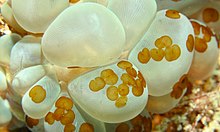Waminoa is a genus of acoels which are epizoic on living corals, using the coral's mucus as a source of food.[1] Unusually, these acoels harbor two genera of endosymbiotic dinoflagellates: Symbiodinium and Amphidinium;[2][3] it is not typical for two different genera of dinoflagellates to coexist in a single host. Waminoa's host coral may also contain dinoflagellates of the genus Symbiodinium but not Amphidinium.[4]
| Waminoa | |
|---|---|

| |
| Waminoa sp. (orange structure) on the Plerogyra sinuosa coral (whitish bubbles). | |
| Scientific classification | |
| Domain: | Eukaryota |
| Kingdom: | Animalia |
| Phylum: | Xenacoelomorpha |
| Order: | Acoela |
| Family: | Convolutidae |
| Genus: | Waminoa Winsor, 1990 |
| Species | |
Only two species belonging to this genus have been discovered (W. litus and W. brickneri) and they inhabit coral reefs in the Red Sea,[5] Australia,[2] and Indonesia.[6]
References
edit- ^ Naumann, Malik S.; Mayr, Christoph; Struck, Ulrich; Wild, Christian (2010-11-01). "Coral mucus stable isotope composition and labeling: experimental evidence for mucus uptake by epizoic acoelomorph worms". Marine Biology. 157 (11): 2521–2531. doi:10.1007/s00227-010-1516-3. ISSN 1432-1793.
- ^ a b Winsor, Leigh (1990). "Marine Turbellaria (Acoela) from North Queensland". Memoirs of the Queensland Museum. 28: 785–800.
- ^ Tyler, Seth; Barneah, Orit; Benayahu, Yehuda; Tekle, Yonas I.; Hooge, Matthew D.; Ogunlana, Maxina V. (2005-06-14). "Waminoa brickneri n. sp. (Acoela: Acoelomorpha) associated with corals in the Red Sea". Zootaxa. 1008 (1): 1–11. doi:10.11646/zootaxa.1008.1.1. ISSN 1175-5334.
- ^ Koike, Kazuhiko; Hikosaka, Akira; Yamashita, Hiroshi; Koike, Kanae; Hikosaka-Katayama, Tomoe (2012). "Mechanisms of Maternal Inheritance of Dinoflagellate Symbionts in the Acoelomorph Worm Waminoa litus". Zoological Science. 29 (9): 559–567. doi:10.2108/zsj.29.559. ISSN 0289-0003.
- ^ Barneah, O.; Brickner, I.; Hooge, M.; Weis, V. M.; LaJeunesse, T. C.; Benayahu, Y. (2007-05-01). "Three party symbiosis: acoelomorph worms, corals and unicellular algal symbionts in Eilat (Red Sea)". Marine Biology. 151 (4): 1215–1223. doi:10.1007/s00227-006-0563-2. ISSN 1432-1793.
- ^ Haapkylä, Jessica; Seymour, Adrian S.; Barneah, Orit; Brickner, Itzchak; Hennige, Sebastian; Suggett, David; Smith, David (2009-04-01). "Association of Waminoa sp. (Acoela) with corals in the Wakatobi Marine Park, South-East Sulawesi, Indonesia". Marine Biology. 156 (5): 1021–1027. doi:10.1007/s00227-009-1145-x. ISSN 1432-1793.